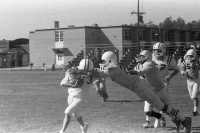
26 Oct Nationwide Children’s: Multiyear Study of Head Impact During Football Seasons Launched
MedicalResearch.com Interview with:
 Sean C. Rose, MD
Sean C. Rose, MD
Pediatric sports neurologist and co-director
Complex Concussion Clinic
Nationwide Children’s Hospital
Assistant professor of Pediatrics
The Ohio State University
MedicalResearch.com: What is the background for this study? What are the main findings?
Response: The link between sub-concussive head impacts and declines in neurocognitive function has been reported by some studies, yet refuted by others. There is very little evidence that has been collected in children as they are sustaining these head impacts.
We initiated a multi-year study of youth football players to provide a more in-depth look at the question. We measured head impacts using helmet sensors during the 2016 football season. 112 players age 9-18 completed a battery of neurocognitive tests before and after the football season.
We found that neither the total burden of head impacts nor the intensity of individual impacts were associated with changes in testing performance from pre to post-season.
MedicalResearch.com: What should readers take away from your report?
Response: Playing one year of tackle football in primary school or high school was not associated with detectable changes in a battery of cognitive tests, concussion and ADHD symptoms, social adjustment, vestibular-ocular function, or balance. However, we tested patients soon after the end of the football season. This analysis was not capable of detecting a delayed onset of problems, or problems related to multiple seasons of play.
MedicalResearch.com: What recommendations do you have for future research as a result of this work?
Response: Other longitudinal studies in youth football, as well as in other contact sports, are necessary to further clarify the association between sub-concussive impacts and changes in neurocognitive function. We are following the patients in our study through subsequent football seasons and will continue to report the data from this study.
MedicalResearch.com: Is there anything else you would like to add?
Response: Thank you to MORE Foundation for supporting this study, The Sports Neurology Clinic for helping conduct the study, and the many members of the research team and coaches and trainers involved. The study was funded by ElMindA and Riddell.
Citation:
[wysija_form id=”3″]
[last-modified]
The information on MedicalResearch.com is provided for educational purposes only, and is in no way intended to diagnose, cure, or treat any medical or other condition. Always seek the advice of your physician or other qualified health and ask your doctor any questions you may have regarding a medical condition. In addition to all other limitations and disclaimers in this agreement, service provider and its third party providers disclaim any liability or loss in connection with the content provided on this website.
Last Updated on October 26, 2018 by Marie Benz MD FAAD
